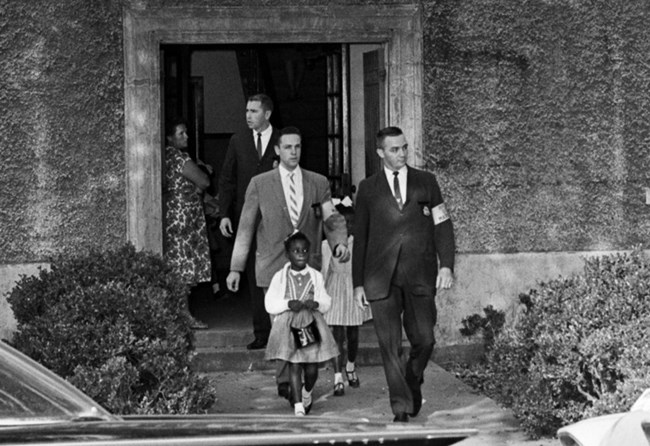Last updated: May 2, 2023
Article
Louisiana: Leona Tate Foundation for Change

Tate, Etienne, and Prevost Interpretive Center

WGNO
Leona Tate was only six years old when she became a civil rights activist and leader. On Nov. 14, 1960, Tate, alongside Gail Etienne and Tessie Prevost, desegregated the previously all-white McDonogh #19 Elementary School. These girls, escorted by federal marshals, were the first black students to attend an integrated public school in Louisiana, along with Ruby Bridges at the nearby William Frantz Elementary. National media covered the desegregation of McDonogh and William Frantz elementary schools highlighting this historic event and the bravery of the four schoolgirls.
Nearly 50 years later, the 2008 historic election of America's first black president, Barack Obama, birthed a renewed sense of activism in Tate. Only a few months later, she founded the Leona Tate Foundation for Change. This foundation is dedicated to the principle that, in order to achieve harmony among humankind, every person should have comparable opportunities and exposures. Providing access to equal educational opportunities for greater New Orleans area youth is an essential component to implementing this principle. For the past five years, the foundation has worked to transform the McDonogh #19 Elementary School building into the Tate, Etienne, and Prevost (TEP) Interpretive Center.
The building closed in 2004 due to the building’s vacancy and abandonment over years. The building suffered additional damage in 2005 due to levee failures from Hurrican Katrina. Following the nomination of the site to the National Register of Historic Places, the foundation received a $500,000 grant from the inaugural round of the National Park Service’s African American Civil Rights (AACR) grant program. The $11 million rehabilitation project received an additional $1 million in combined funding from the AACR grant program and the Save America’s Treasures (SAT) program from the National Park Service over the following two years. Grant assisted activities included structural stabilization of the nearly 100-year-old building, exterior repairs to the roof and masonry, mold and asbestos remediation, along with new mechanical, electrical and plumbing systems in the building.
On May 4, 2022, McDonogh #19 reopened as the Tate, Etienne, and Prevost Center. The multi-use facility features: an interpretive exhibit centered around the New Orleans Public School Desegregation Experience; office headquarters for the Leona Tate Foundation, People's Institute for Survival and Beyond, and Beloved Community; and 25 subsidized, affordable apartments for area seniors.
The African American Civil Rights Grant Program, which works to document, interpret, and preserve the sites and stories related to the African American struggle to gain equal rights, has contributed $1 million in funding for the rehabilitation work at McDonogh #19 as the new home of the TEP Interpretive Center.
The Save America’s Treasures Grant Program, which supports the preservation of nationally significant properties and collections, has contributed $500,000 to the rehabilitation of the McDonogh #19 as the new home of the TEP Center.
The African American Civil Rights Network (AACRN) recognizes the civil rights movement in the United States and the sacrifices made by those who fought against discrimination and segregation. Created by the African American Civil Rights Act of 2017, and coordinated by the National Park Service, the Network tells the stories of the people, places, and events of the modern U.S. civil rights movement from 1939 -1968 through a collection of public and private elements.
